Ditt meddelande har skickats.
Vi behandlar din begäran och återkommer till dig så snart som möjligt.
Formuläret har skickats in framgångsrikt.
Ytterligare information finns i din brevlåda.
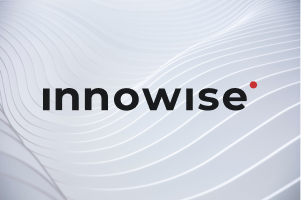
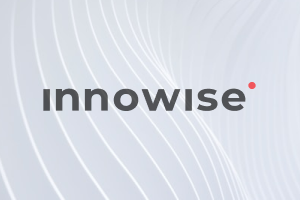

Har du någonsin kämpat med mjukvaruprojekt som ständigt överskrider budget, missar deadlines eller misslyckas med att uppfylla användarnas förväntningar? Kanske har ditt team haft svårt att definiera kraven från början, eller så har ansvarsområdena känts utspridda, kommunikationen haltat och framstegen gått i stå. Du är inte ensam - dessa utmaningar är otroligt vanliga, men det finns ett beprövat sätt att ta itu med dem.
Det är precis vad SDLC (livscykel för programvaruutveckling) är byggd för att lösa. Det ger en strukturerad och repeterbar metod för att planera, bygga och leverera programvara som faktiskt fungerar.
I den här artikeln går jag igenom vad SDLC egentligen innebär idag, hur det hjälper dig att klargöra din process från dag ett och hur det kan hjälpa dig att konsekvent leverera programvara snabbare och med mycket färre överraskningar.
Software Development Life Cycle (SDLC) är en strukturerad väg för dina mjukvaruprojekt som bryter ner komplexa processer till hanterbara steg - från det första konceptet till driftsättning och löpande support. Varje fas innehåller specifika uppgifter, tydliga roller och konkreta leveranser, så att alla inblandade är på samma sida och vet vad de ska göra.
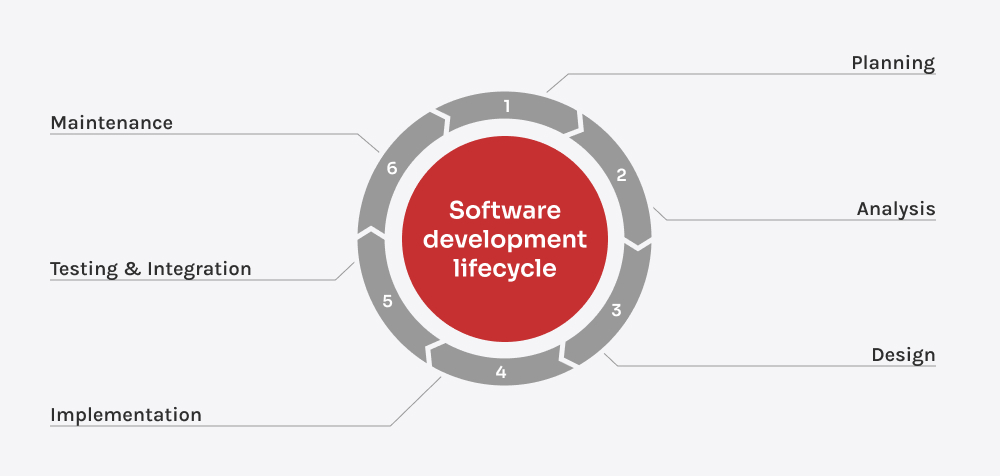
Mjukvara kommer inte till liv i en rak linje. Den utvecklas genom en serie avsiktliga SDLC-faser. SDLC guidar den resan och hjälper teamen att hålla sig i linje, minska riskerna och forma produkter som faktiskt uppfyller användarnas och verksamhetens behov.
Det här är fasen "varför gör vi det här". Det är här som teamen definierar projektets syfte, omfattning, mål, budget och tidsramar för leverans. Affärsanalytiker och projektledare arbetar nära intressenterna för att identifiera smärtpunkter och skissera en strategi på hög nivå. Vad som görs här: intervjuer med intressenter, genomförbarhetsstudier, riskbedömningar och resursplanering.
När projektet har godkänts går teamet vidare med att definiera vad programvaran faktiskt ska göra. Det första steget är att samla in synpunkter från alla intressenter för att förstå både affärsbehov och användarnas förväntningar. Detta leder till dokumentation av funktionella krav (vad användarna ska kunna göra) och tekniska krav (hur systemet ska fungera under huven). I det sista steget granskar och förfinar teamet kraven innan man går vidare.
I designfasen omvandlar teamet de obearbetade kraven till en praktisk plan för hur programvaran ska byggas. Det börjar med design på hög nivå - en kartläggning av systemets arkitektur, huvudmoduler, dataflöde och hur olika delar ska samverka. Därefter går man vidare till lågnivådesign och beskriver varje komponents logik, struktur och beteende, inklusive databaslayouter och nyckelalgoritmer. Designers skapar ofta trådramar eller klickbara prototyper för att utforska användarresan och fånga upp användbarhetsproblem tidigt. Detta steg eliminerar gissningar för utvecklare och hjälper till att undvika kostsamma omarbetningar genom att tekniska utmaningar kommer upp till ytan innan någon kod skrivs.
I utvecklingsfasen börjar programvaran ta form när utvecklarna översätter designen till fungerande kod. De bygger applikationen bit för bit, ofta i korta, fokuserade cykler som möjliggör frekventa tester, feedback och justeringar. Utvecklarna skriver inte bara kod - de gör medvetna arkitektoniska val och strukturerar funktioner för långsiktig underhållbarhet. Under hela processen är utvecklarna nära synkade, granskar varandras arbete, förfinar logiken och löser problem tillsammans för att se till att produkten ligger i linje med både den tekniska visionen och affärsmålen.
Oavsett hur polerad kodbasen är, så är otestad programvara en tickande bomb. Testfasen är den fas där produkten testas innan den når användarna. Den inleds vanligtvis med systemtestning, där man kontrollerar att hela applikationen fungerar som en enhet. Sedan kommer manuell testning, där QA-ingenjörer simulerar verklig användning och kantfall. Slutligen kommer automatiserad testning in för att täcka repetitiva uppgifter i stor skala och säkerställa stabilitet efter varje ny driftsättning.
Driftsättning är när programvaran lämnar labbet och kommer ut i den verkliga världen. Teamet rullar ut produkten till användarna - antingen i en stor lansering eller gradvis genom stegvisa releaser - samtidigt som man noga övervakar dess beteende i livemiljön. Den här fasen innebär att konfigurera infrastruktur, sätta upp automatiserade distributionspipelines och förbereda rollback-strategier ifall något går snett. Utvecklare, DevOps-ingenjörer och QA arbetar ofta sida vid sida för att underlätta releaseprocessen, åtgärda problem i sista minuten och se till att allt fungerar precis som det ska från dag ett.
När programvaran är live börjar det verkliga testet. Teamet övervakar prestanda, svarar på användarnas feedback och hanterar buggar eller sårbarheter som dyker upp under verkliga förhållanden. Lika viktigt är att supportteamen arbetar i frontlinjen och samlar in insikter från användarna, medan utvecklarna hanterar tekniska justeringar och långsiktiga förbättringar. Programvaran blir en levande produkt - ständigt förfinad för att förbli relevant och tillförlitlig.
Hur du bygger programvara spelar lika stor roll som vad du utvecklar. SDLC-modeller ger struktur åt kaoset - och hjälper teamen att navigera mellan skiftande mål, snäva deadlines och den ständiga dragkampen mellan kvalitet och snabbhet.
Vattenfallsmodellen är ett linjärt och sekventiellt tillvägagångssätt. Den består av distinkta faser: Krav, design, implementering, testning, driftsättning och underhåll. Varje fas måste slutföras innan man kan gå vidare till nästa. Det finns ingen återvändo när en fas är klar. Den här modellen fungerar bra när kraven är väldefinierade och sannolikt inte kommer att ändras.
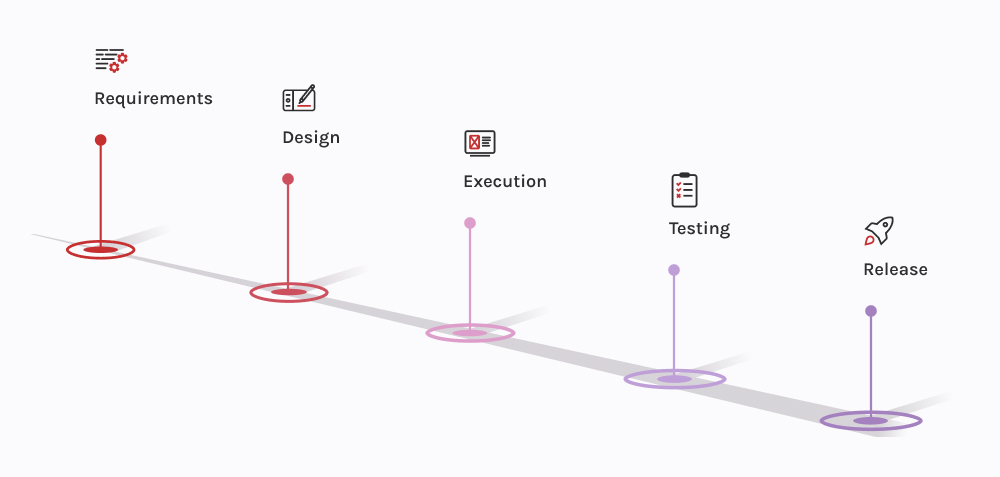
Den agila modellen delar upp projektet i små, hanterbara delar som kallas sprintar och som vanligtvis varar 2-4 veckor. Under varje sprint utvecklar, testar och samlar teamen in feedback för att göra förbättringar. Agile betonar kundsamarbete och flexibilitet, vilket gör att ändringar kan göras även sent i utvecklingen. Populära Agile-ramverk är Scrum och Kanban. Det är idealiskt för projekt där kraven ändras ofta, t.ex. programvara med regelbundna uppdateringar.
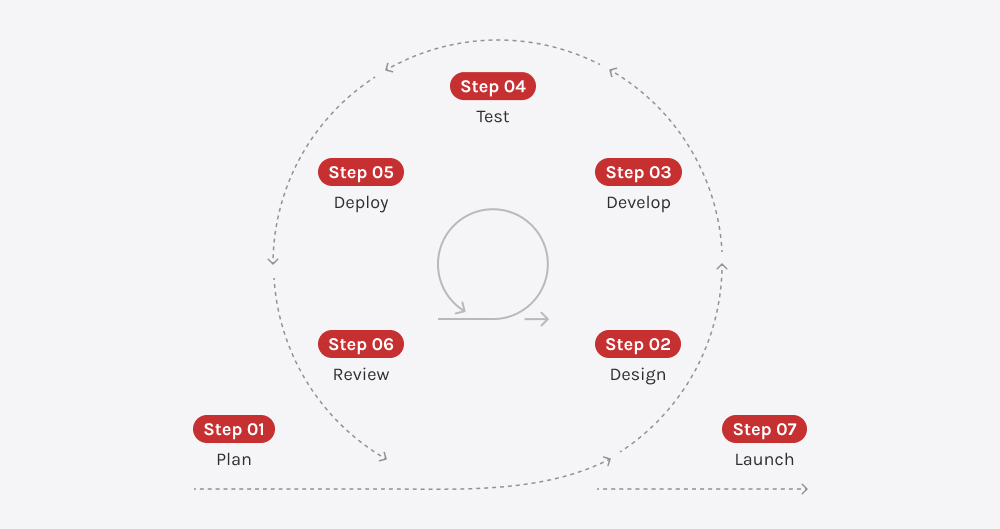
Med den iterativa modellen kan du bygga programvara steg för steg. Du börjar med en enkel version av produkten och fortsätter sedan att förbättra den i flera omgångar. För varje iteration planerar, designar, kodar och testar teamet nya funktioner eller förbättringar. Det är ett bra val när projektets omfattning inte är helt spikad i början eftersom du kan anpassa och förbättra under arbetets gång.

Spiralmodellen kombinerar iterativ utveckling med systematisk riskbedömning. Den består av fyra huvudfaser: Planering, riskanalys, teknik och utvärdering. Varje loop i spiralen behandlar en uppsättning krav, med riskbedömning i varje steg. Modellen upprepar processen och lägger gradvis till fler funktioner. Den används för stora, komplexa eller riskfyllda projekt, t.ex. inom flyg- och rymdindustrin eller för kritiska programvarusystem.
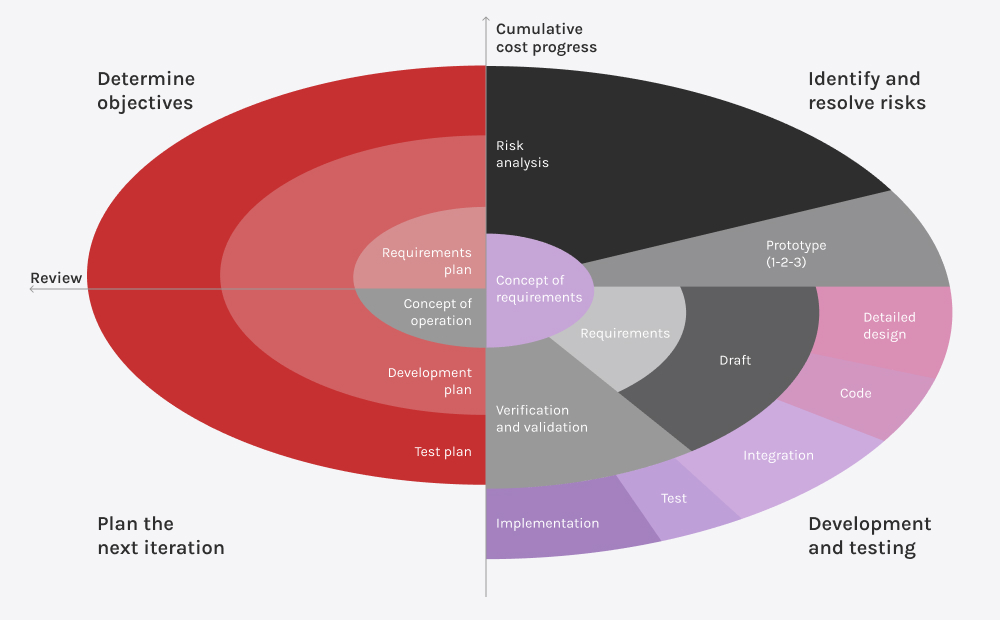
Denna modell liknar vattenfallsmodellen men integrerar omfattande testning i varje steg. Efter att en utvecklingsfas har slutförts följer en motsvarande testfas. Detta gör den mer tillförlitlig för projekt där noggrannhet och validering är avgörande.
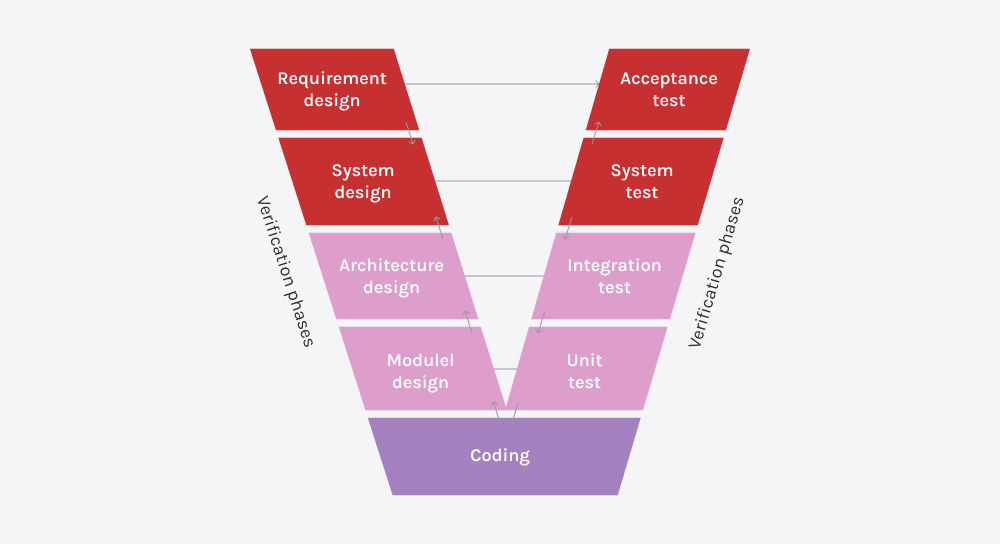
Big Bang-modellen innebär att man startar utvecklingen utan någon större planering. Utvecklarna skapar programvaran utifrån begränsade krav och siktar ofta på en snabb prototyp. Den här modellen är riskfylld och kan leda till oförutsägbara resultat, men den är lämplig för små projekt med enkla krav eller experimentell programvara.
Den DevOps är ett tillvägagångssätt som kombinerar mjukvaruutveckling (Dev) och IT-drift (Ops) för att förbättra samarbete, hastighet och effektivitet. Den fokuserar på att automatisera repetitiva uppgifter som testning, integration, driftsättning och övervakning.

Att välja rätt SDLC-modell kan sätta tonen för hela ditt projekt. Det finns inte en modell som passar alla - vilken som passar bäst beror på saker som projektets storlek, komplexitet, budget, deadlines, hur erfaret ditt team är och hur involverade dina intressenter vill vara.
Låt oss titta på hur du kan para ihop olika SDLC-metodiker med typiska projektegenskaper:
| Faktor | Rekommenderade SDLC-modeller |
| Tydliga krav | Vattenfall, V-modell |
| Förändrade krav | Agil, iterativ |
| Små projekt | Vattenfall |
| Stora eller komplexa projekt | Agil, spiralformad, DevOps |
| Frekvent kundinteraktion | Agil, Scrum |
| Minimal kundinteraktion | Vattenfall, V-modell |
| Fast budget och tidslinje | Vattenfall, V-modell |
| Flexibel budget och tidslinje | Agil, spiralformad |
| Snabbkoppling behövs | Agil |
| Längre utvecklingstid | Vattenfall, V-modell |
| Kontinuerligt underhåll | Agil, DevOps |
Att använda en SDLC-strategi (Software Development Life Cycle) kan verkligen förändra hur smidigt dina programvaruprojekt går. Så här hjälper SDLC till att göra hela processen mycket mer hanterbar och effektiv:
På Innowise har vi själva sett hur programvaran livscykel för utveckling (SDLC) gör livet enklare för våra team och våra kunder. Genom att följa bästa praxis för SDLC håller vi oss på samma sida med alla inblandade och definierar tydligt mål och förväntningar redan från början. Det innebär färre överraskningar, smidigare processer och förutsägbara resultat i varje steg, från planering och utveckling till testning och driftsättning.
Funderar du på att uppgradera din egen metod? Kolla in vår servicesida och se hur vi kan hjälpa dig att skapa klarhet och effektivitet i ditt nästa mjukvaruprojekt.
Dmitry leder den tekniska strategin bakom anpassade lösningar som faktiskt fungerar för kunderna - nu och när de växer. Han kopplar samman visioner med praktiskt utförande och ser till att varje lösning är smart, skalbar och anpassad till verksamheten.
Betygsätt den här artikeln:
4,8/5 (45 recensioner)












Ditt meddelande har skickats.
Vi behandlar din begäran och återkommer till dig så snart som möjligt.

Genom att registrera dig godkänner du vår Integritetspolicy, inklusive användning av cookies och överföring av din personliga information.